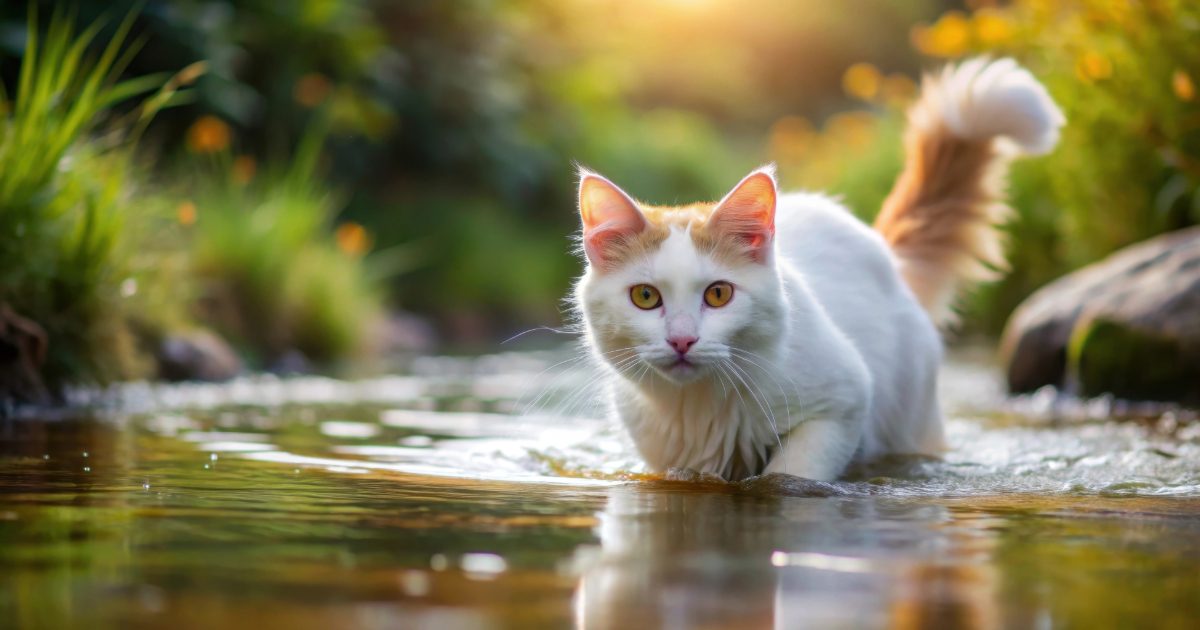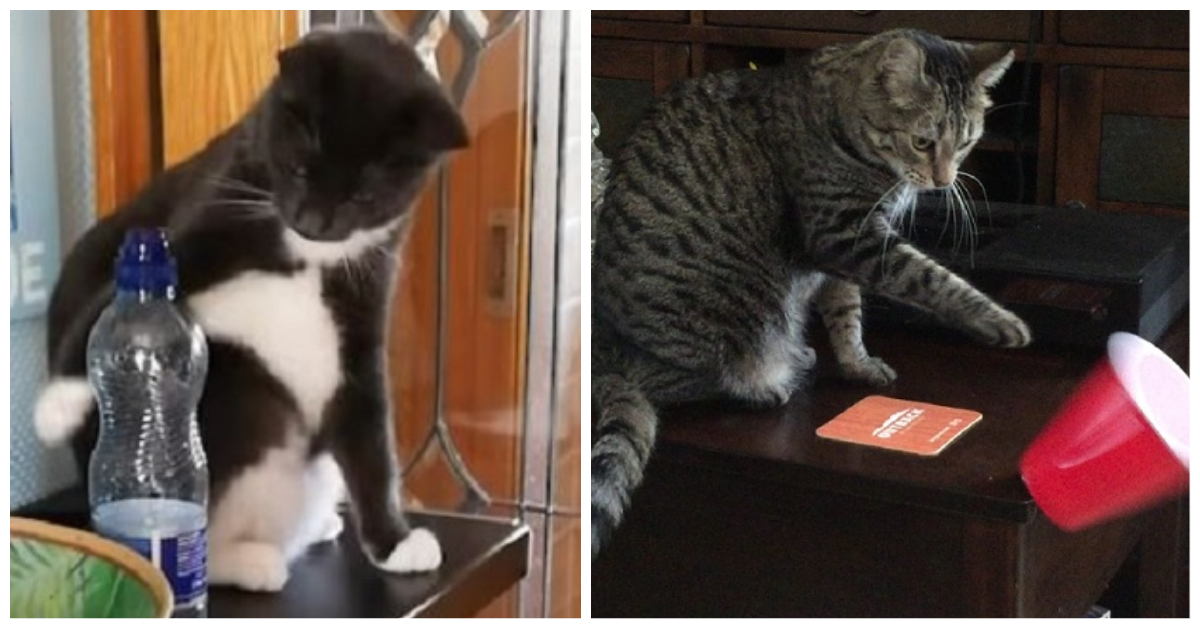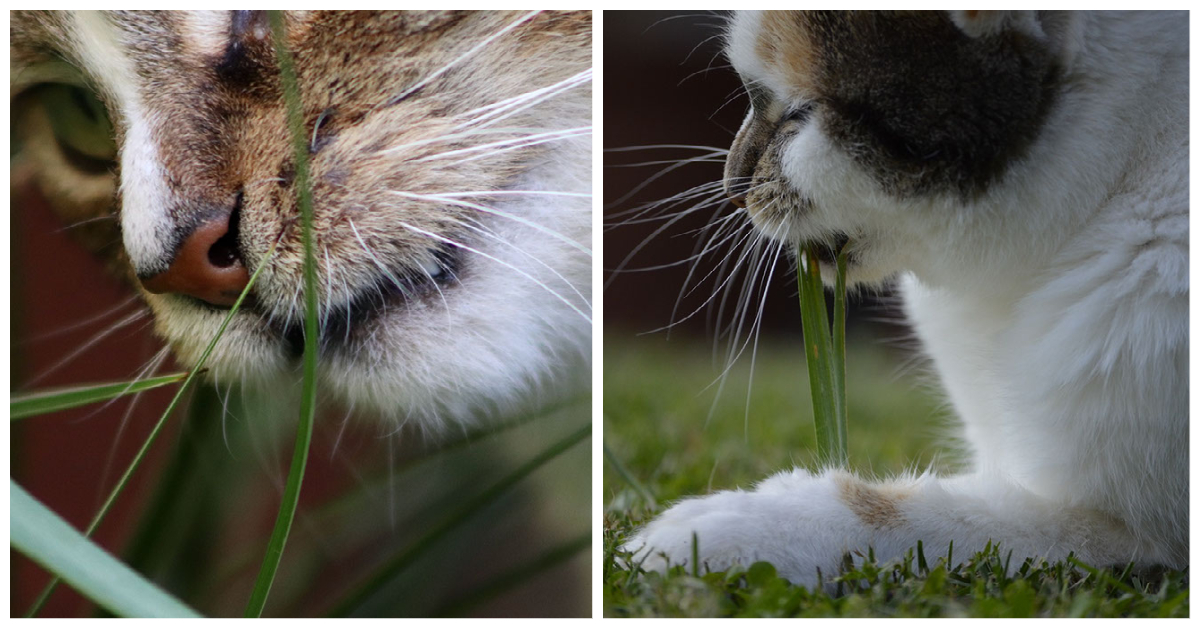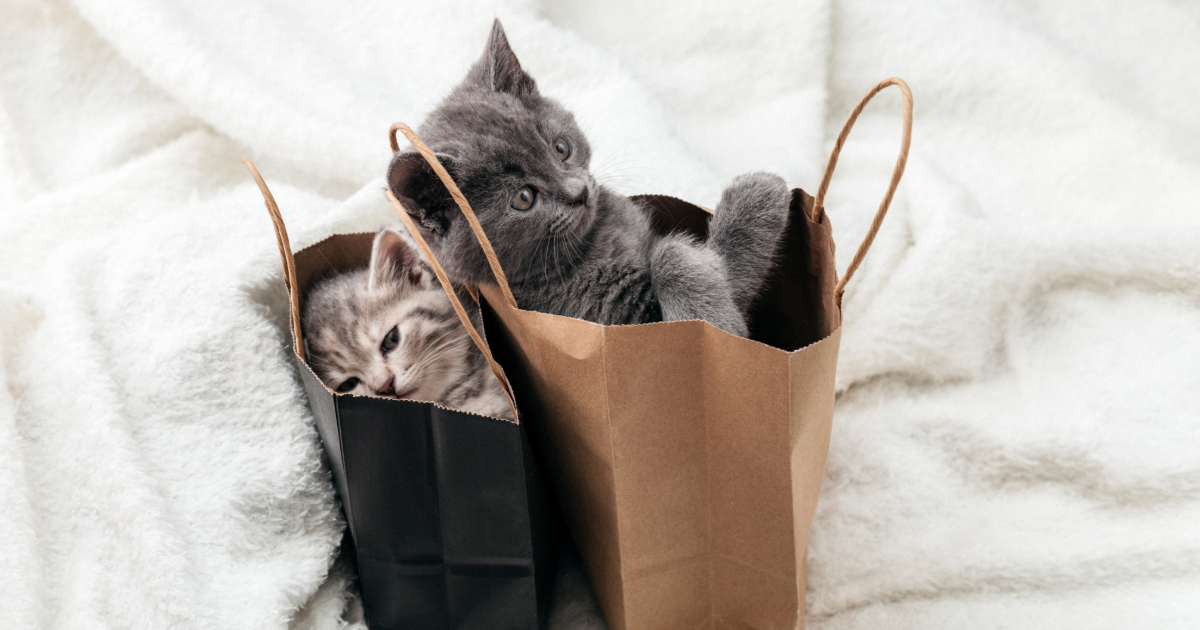Their are several strange Cat behaviors where humans question what and why their cat is displaying these behaviors. For cat parents, these are also know as weird cat habits, odd cat behaviors or just strange things that cats do.
20 Strange Cat Behaviors Explained
1) Sitting In or On Boxes and Paper Bags – As a predator that may also be prey, cats love the security and hiding capability of a cardboard box. As a predator, the box or paper bag makes for a great hiding place and the ability to launch out of the box and ambush potential prey. This is normal feline behavior as an ambush predator. As potential prey, the box also offers an escape spot and a snug place to hide. When dealing with stressful situations or strangers visiting the house, cats love a great place to run and hide. Most cats prefer to have many hiding places and escape spots within the house. Bags are cardboard boxes also provide an appealing texture for a cat’s claws. Tight spaces are a great insulator and provide warmth. Since the normal body temperature of cats is in the range of 101.0 to 102.5°F (38.3 – 39.2°C), they love cardboard boxes as a small space to curl up, relax, and make a warm and comfy space via the cats natural body heat.

2) Sitting On Electronic Equipment – Cats may sit on or near electronics, like computers and TVs, because they’re warm and have stimulating images on their screens. If a human is present, a popular reason for cats sitting on the TV or your computer is to capture human attention. Cats love warmth, so any object that radiates heat will attract a cat.
3) Running Around In the Middle of the Night (the Zoomies) – Since cats are nocturnal, it’s natural that they will be more active at night. Since we’re often not home during the day, they spend a lot of that time sleeping. You can help increase your cat’s activity level during the day by providing her with engaging feeding toys or by establishing a playtime routine before you leave the house and after you return. Before you go to bed, play with your cats to help them expend energy, so they can get more rest at night. A feeding routine that supplies cats with more energy during the day instead of at night might also help.
4) Stealing – Some cats steal almost any object they can get their paws on. This is a way for a cat to gain human interaction and is a form of cat play. Stealing may also be related to texture as cats enjoy the mouthfeel of different textures. If your cat is taking things and moving them around – like socks – it could be a predatory instinct, and the sock is being used as a replacement for prey that has been killed and brought back.
5) Attraction to Water – Many cats love water, although they don’t respond to it the same way dogs do. Cats prefer to approach water on their own terms, and often dislike having it imposed on them. When it comes to drinking water, cats are often more attracted to running water or droplets of water because that’s one way they interact with it in nature. Cat instinct is that running water is safer and less likely to house harmful bacteria as still water. This is an instinct passed from wild cats to domestic cats over thousands of years of cat behavior. Certain cat breeds are known to love water and will jump into water. Other cat breeds are less enthused about getting wet.

6) Chattering or Chirping at Birds – When your cat sees a bird or wildlife outside the window, they might chatter at it. Chattering is a distinctive, repetitive clicking sound made from a combination of lip smacking and your cat rapidly vibrating their lower jaw. This odd behavior looks like teeth chattering, and a lot of cats also sprinkle in soft, birdlike “chirp” sounds. This strange cat trait is thought to be a mix of predatory excitement and frustration at not being able to get to the bird that’s making them excited.
7) Presenting Their Butt – Isn’t it enough that kitty asks for a scratch with an elevator butt pose? What’s up with presenting its tail to your face? Your cat’s action is a backhanded compliment and kitty-correct. A raised tail signals another cat that your cat feels secure and is graciously offering the opportunity of a butt sniff. When your cat does this to you, it is like giving a hug and kiss in greeting a friend. The good news is that you don’t have to sniff your cat’s hind end to reciprocate. Instead, you can pet your cat or scratch where it likes it best.
8) Head Bumping or bunting – cat head-butts you. The technical term is bunting and refers to the way a cat presses and rubs its head against objects. Another technical term, allorubbing, refers to the way cats rub their bodies against another cat, a human, or even a trusted family dog. This is done to mark you with their scent and claim you as their own. Pheromones are actually being released from his head and it is his way of showing ownership over you. Just as a cat would rub on furniture to leave his scent to mark his territory- he is showing pride in that you are his. When a cat cheek-rubs you, head-bumps your face, or pushes against you, he leaves his scented signature. These behaviors, termed “bunting”, are expressions of affection cats display to other cats, dogs and their most favorite people. Cats will rub against you to mark their scent and identify you as an important family member. When a cat cheek-rubs you, head-bumps your face, or pushes against you, he leaves his scented signature. These behaviors, termed “bunting”, are expressions of affection cats display to other cats, dogs and their most favorite people. Cats will rub against you to mark their scent and identify you as an important family member.
9) Knocking things of tables and ledges – You know what they say about cats and curiosity, well it is as simple as that- he is just curious and potentially bored! Although this is entertaining for him, you may want to try stimulating him with some new toys if you’d like to curb this naughty habit.

10) Covering or burying food – If your cat is covering its food after eating some of it, it may be an instinctive behavior as wild felines cache their food to keep it safe from others. If your cat doesn’t like his own main dish, he might just walk off in protest. Some cats, though, display an ineffective instinctual behavior–they try to bury the food. In a less-tame environment than your home, a cat might want to cover the carcass of a dead animal it had killed to avoid attracting other predators to its own territory.
11) Kneading – One of my very favorite happy cat behaviors is kneading or “making bread.” This weird behavior is a leftover from the cat’s days of nursing on mom. Using their paws to manipulate the mammary glands stimulates the production of milk. It may also be a calming or enjoyable repetitive behavior that makes your cat feel relaxed or sleepy. It is likely that kneading is also used for scent marking, since a cat has scent glands in its paws as well. Many cats show at least some kneading behavior throughout their lives, but some take it to a real art form–pawing, purring, and drooling combined. this behavior goes back to kittenhood. Kitten paws knead against the mother cat to induce milk flow. Adult cats often continue this behavior with their owners when they feel most relaxed, content, and loved. Your cat kneading on you is a sign of love and affection.

13) Staring Intensely at Nothing – Cats sometimes fixate on spots where nothing is visibly happening. This may be due to their heightened senses, catching subtle sounds or movements that we can’t detect.
14) Bringing “Gifts” – Cats, especially those allowed outdoors, may bring home small prey like birds or mice. This behavior harks back to their hunting instincts, and they may see it as providing for their human “family.”
15) Licking or Chewing on Plastic – Some cats have a fascination with plastic bags or other items. This could be due to texture or the faint scent of food, but in some cases, it might indicate a condition called pica, where animals eat non-food objects.
16) Exposing Their Belly, Then Scratching – A cat rolling over and showing its belly may seem like an invitation for petting, but often it’s just a sign of trust or relaxation. Many cats dislike belly petting and may scratch if touched in this vulnerable area.
17) Tail Twitching or Flicking – When a cat’s tail is twitching, it’s a subtle indicator of mood. A twitching tail can signify excitement, agitation, or even annoyance, depending on the context and other body language.
18) Slow Blinking or “Cat Kisses” – Cats may give slow blinks to show trust and affection. This is often referred to as a “cat kiss” and is a friendly, non-threatening signal.
19) Staring at the Ghost cat in the mirror – many cats are mesmerized by their image in the mirror or seeing their reflection. Many cats will dance and paw at the strange creature staring back at them from the glass.
20) Eating Grass – Cats eat grass for a few different reasons. Grass juice contains folic acid that cats may crave – folic acid is an important vitamin that supports a cats’ growth and helps increase oxygen levels in their blood. If your cat is grazing on grass, it may be because they are battling a dietary deficiency and are in search of a folic acid vitamin boost. Eating Grass provides for natural laxative benefits – Eating grass provides a source of fiber and helps your cat have regular bowel movements. This is especially important for cat digestive tracts that are sometimes clogged by fur (hairballs). Broad grasses seem to have the best laxative effect and narrow grasses appear to help a cat settle an upset stomach. Cats may eat a larger amount of grass to intentionally relieve an upset stomach. Eating a large portion of grass can help a cat to vomit and your cat is eating grass on purpose to cause this desired reaction. Cats don’t have the necessary enzymes to digest a large amount of grass, which is why eating a bigger portion of grass can make them sick. In the process of throwing up, your cat clears their stomach (e.g. of fur, feathers, parasites, bones, or other irritants) that upset their digestive tract or may even cause more lasting illness.

Remember to “share” these strange cat behaviors with other cat fans and “subscribe” to our CatFancast Channel on YouTube.


